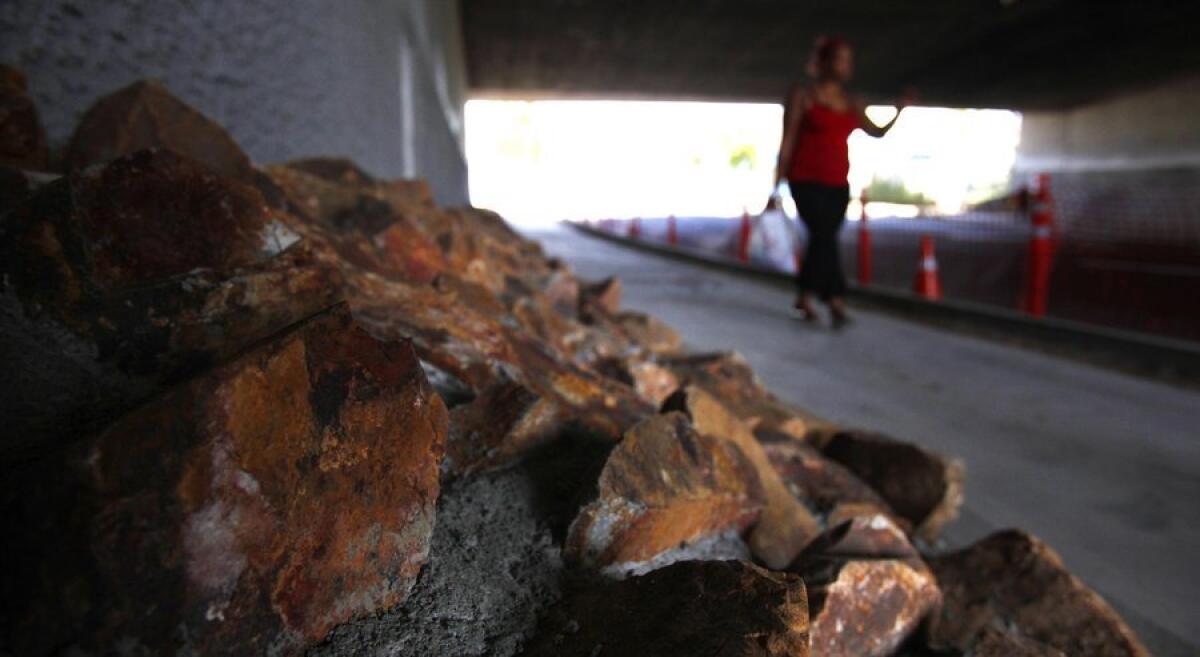San Diego places rocks under freeway to move out homeless ahead of baseball’s All Star Game

Reporting from San Diego — In late April, after jagged rocks were installed along a freeway underpass to drive out homeless encampments, a city spokesman told reporters the project was at the request of residents of Sherman Heights, a working-class neighborhood just east of the 5 Freeway, who felt unsafe walking down Imperial Avenue.
Turns out, it had more to do with San Diego’s upcoming time in the spotlight as the host of baseball’s All Star Game at Petco Park on July 12.
Sherman Heights is never mentioned in more than 700 pages of email documents about the rocks, obtained under the California Public Records Act.
According to the emails, John Casey, who up until March was the city’s ballpark administrator and liaison with the Padres, came up with the idea for the rocks and urged the project along.
Casey included the rocks in a checklist of work to be done before the All-Star Game. Emails also show that initial plans called for rocks along the base of a wall at Tailgate Park, between 12th and 14th streets and outside the New Central Library — which overlooks the ballpark — to keep away homeless people.
Emails show Casey took the lead on getting price quotes for the rocks, installed along both sides of an underpass at the 5 and Imperial.
In September, he sent an email to City Traffic Engineer Linda Marabian that included a photo of rocks he’d seen at a Harbor Island jetty. He used photo-editing software to superimpose those rocks along the underpass.
“Here are the famous rocks!!” he wrote.
“They don’t look as friendly as ours,” Marabian replied. “We’ll send you ours.”
“We want to look mean!!!!” Casey responded.
In a later email, Casey emphasized that the rocks needed to be of different heights so that no one could put down a plank of wood to try to sleep.
The city ultimately went with Casey’s choice of rocks, the records show.
Marabian cautioned in an email last July, when the project was first being discussed, that it could have unintended consequences for the surrounding area.
“Unfortunately, if we remove people from sleeping here,” she wrote, “they will go around the corner and sleep somewhere else.”
Councilman David Alvarez, whose district includes Sherman Heights, said his office never was consulted on the project. He said the rocks have driven encampments further into Sherman Heights.
After the internal emails were reported by the Voice of San Diego news outlet earlier this week, Alvarez said he wants an apology from the city.
He believes Sherman Heights residents were used to deflect criticism of the project. While residents had complained about feeling unsafe walking under the freeway, they’d asked for better lighting, Alvarez said, a request that’s yet to be fulfilled.
“Somebody at some point made the decision to allow these rocks to be placed there,” he said. “That was not what the community asked for.”
Michael McConnell, a homeless advocate, first drew attention to the rocks with photos posted to his Facebook page, Homelessness News San Diego.
“Every person I take out there is astonished at how vicious it looks,” he said. “If you want to look like a third-world country, you do what the city just did.”
At the time, city officials released a statement saying: “The new landscaping along Imperial Avenue is meant to address safety concerns raised by neighborhood residents in Sherman Heights who use it as their main connection to downtown. The improvements will help ensure the pathway remains safe and passable for pedestrians and there has already been significant positive feedback from neighborhood residents.”
Now, McConnell said, he believes the rocks are part of a larger effort that includes stepped-up sweeps targeting encampments to clear homeless people out of East Village before the All-Star Game.
kelly.davis@sduniontribune.com
Davis writes for the San Diego Union-Tribune
More to Read
Sign up for Essential California
The most important California stories and recommendations in your inbox every morning.
You may occasionally receive promotional content from the Los Angeles Times.










